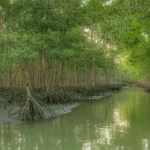
By, Eco Trails
- 84 Views
- 7 Min Read
- (0) Comment
A maze of roots, rivers & secrets
The Sundarbans is one of the world’s most mysterious places — a sprawling green maze of mangroves where land and water are constantly trading places. It’s a land where muddy banks hide fresh tiger paw prints, ancient folklore whispers through the leaves, and tiny channels suddenly open up into breathtaking wide rivers.
At Sundarban Eco Trails, we design your journey to not just show you famous sights, but to help you feel the magic of this unique ecosystem. From colonial-era bungalows to canopy walks above tangled roots, every stop adds another layer to your Sundarban story.
Hamilton’s Bungalow: Echoes of the past
Your adventure often starts with a visit to Hamilton’s Bungalow in Gosaba, a historic house that once belonged to Sir Daniel Hamilton. In the early 1900s, Hamilton was a Scottish businessman who became devoted to this region. He set up cooperative movements, schools, and projects that uplifted local villagers.
Today, walking through the quiet rooms and airy verandas of his bungalow feels like stepping back in time. It’s an unexpected piece of history nestled among rivers and forests, and sets the perfect tone for a journey that is as much about people and culture as it is about wildlife.
Sajnekhali Wildlife Sanctuary: The heart of the Sundarban experience
Next, your boat takes you deeper into the forest to the Sajnekhali Wildlife Sanctuary. This is one of the best-managed zones of the Sundarbans and is often your first introduction to the true mangrove wilderness.
At Sajnekhali, you’ll find:
- A watch tower offering panoramic views over mud flats and creeks, a prime spot for spotting deer, wild boar, or even a tiger on lucky days.
- A small museum that explains the delicate balance of this ecosystem, showcasing preserved local fish, crabs, and birds.
- A crocodile pond where you can safely watch these ancient reptiles bask or slide into the water.
- An informative interpretation center and temple dedicated to Banobibi, the forest goddess who locals believe protects them from tigers.
Being here grounds you. You start to see just how intertwined life is with these rivers and forests.
Sudhanyakhali: Watching for tigers
Another popular stop is Sudhanyakhali, where a tall watch tower lets you peer out over wide clearings and small freshwater ponds. This is one of the most reliable places for tiger sightings.
Even if the tiger stays hidden, you’re likely to spot groups of spotted deer grazing, monitor lizards slinking along mud banks, and countless birds swooping low over the water. The stillness here is almost electric — every rustle of leaves feels like a clue.
Do Banki Canopy Walk: A different view of the forest
Few experiences feel as special as the canopy walk at Do Banki. Here, a carefully built hanging walkway stretches above dense mangrove roots and muddy ground, giving you a bird’s-eye perspective of this tangled world.
From above, you see how the roots form natural sculptures, crabs scuttle across mud flats, and birds dart from tree to tree. It’s one of the few places where you truly understand how layered this ecosystem is — from the water-dwelling fish and crabs to the treetop nests of herons and kingfishers.
Pir Khali, Gazi Khali & Sundarkhali: Quiet corners full of life
Your boat trip will weave through lesser-known channels like Pir Khali, Gazi Khali, and Sundarkhali. These places aren’t major tourist names, but that’s exactly why they’re wonderful.
Here, the forest feels almost personal. You’ll see fishermen mending nets on narrow banks, women gathering leaves for fuel, and countless mud holes where small crabs pop in and out. Look carefully and you might catch dolphins breaking the water’s surface, or deer darting through clearings.
In these calm stretches, the true rhythm of Sundarban life reveals itself.
Banobibi Bharani: Where stories breathe
No Sundarban tour is complete without hearing about Banobibi, the goddess of the forest. At places like Banobibi Bharani, your guide might tell you tales of how Banobibi protects honey collectors and fishermen from Dakshin Ray, the tiger demon.
Locals still hold simple shrines and small festivals in her honor, blending Islam and Hindu beliefs into a rich, unique folk culture. Listening to these stories while surrounded by the very forests that inspired them makes them feel powerfully real.
The bird forest & hidden creeks: For patient eyes
Part of your journey might include drifting through areas simply called “bird forests,” where thick trees hang low over narrow water channels. Kingfishers with electric blue wings flash by. Egrets stand like white statues in the shallows. Sometimes flocks of whimbrels or herons rise all at once, turning the air into a soft explosion of feathers.
If you’re lucky, you might spot rarer beauties like the mangrove pitta or a lesser adjutant stork. These slow boat rides are peaceful, almost meditative — perfect for families or groups to sit quietly together and wait for surprises.
Optional cockle boat rides: A deeper dive into the mangroves
For those who crave a little more adventure, we often arrange short trips in small cockle boats. Unlike the big, comfortable mechanised boats, these narrow, low boats slip through the tightest creeks.
It’s a thrilling experience — the water is close, the roots seem to reach out, and every turn feels like it might reveal something incredible. It’s also where you often see the freshest tiger pugmarks, or the tiny mudskippers that hop across the wet flats.
Why these trails matter
Seeing the Sundarbans isn’t just about ticking off spots on a map. Each stop, from Hamilton’s Bungalow to the quietest unnamed creek, teaches you something different.
- Hamilton’s Bungalow connects you to the history of people who tried to tame and help this land.
- Watch towers like Sajnekhali and Sudhanyakhali show you how the forest guards work tirelessly to protect wildlife.
- Banobibi stories root you in a spiritual landscape where people still ask permission from the jungle before entering.
- Canopy walks and cockle boat rides remind you just how complex and delicate this environment is.
All of it deepens your respect for the Sundarbans — not just as a place to visit, but as a living, breathing wonder that needs careful protection.
What guests often say after exploring these trails
Guests often tell us that they came expecting to see a tiger, or maybe some deer — but they leave talking about much more.
They remember the way the sunlight caught on wet mangrove leaves, how the air was filled with bird calls they’d never heard before, or how thrilling it felt to spot a monitor lizard lounging like a tiny dinosaur on a log.
Families say they bonded in quiet moments on the deck. Groups laugh about who spotted the first crocodile eyes peeking above water. For many, it’s the gentle weaving together of big and small sights that makes the trip unforgettable.
Tips for making the most of your Sundarban explorations
✅ Bring binoculars. The birds alone make it worthwhile.
✅ Wear light clothes and carry a hat. The sun can be strong, even under forest cover.
✅ Be patient and stay quiet. Many animals come into view when they don’t feel disturbed.
✅ Ask your guides questions. They have incredible local knowledge and love sharing stories.
✅ Just breathe and take it in. The forest has a way of revealing itself if you slow down enough.
Come explore with us
At Sundarban Eco Trails, we’ve planned every detail so you can simply show up, step on board, and start discovering. From the historic charm of Hamilton’s Bungalow to the thrill of spotting fresh tiger marks, from wide rivers to hidden creeks where silence is broken only by a bird’s call, this is a journey that fills your senses and heart.
Come with your family, bring your closest friends, or travel with a group eager to experience something real. The Sundarbans is waiting — tangled roots, flowing rivers, whispered legends and all.






Leave a comment: